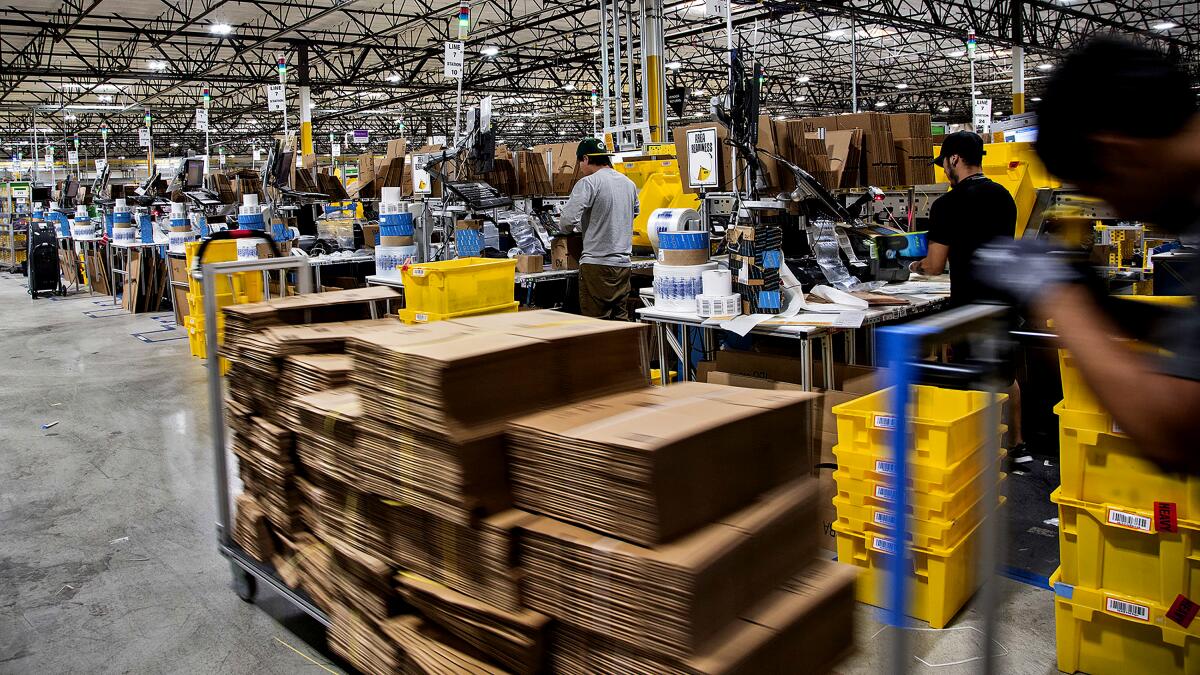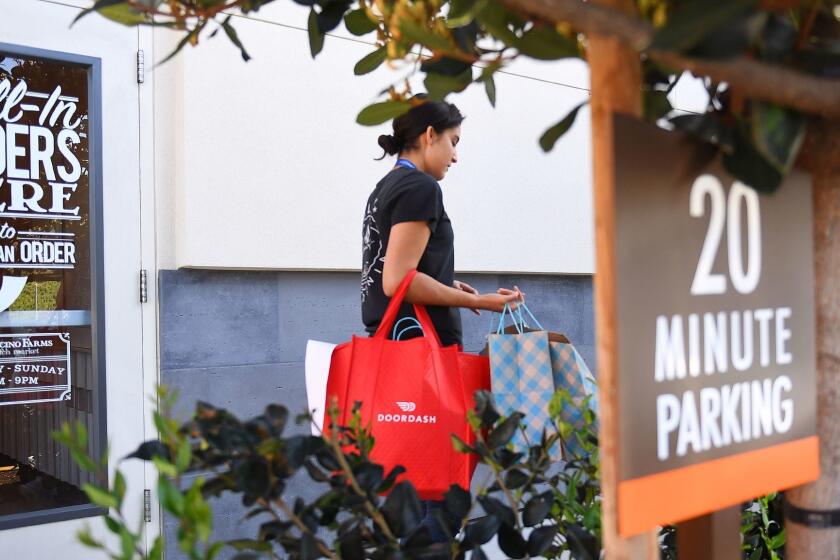Fearful of COVID-19, Amazon workers ask for state probe of working conditions

- Share via
Workers at Amazon’s Eastvale fulfillment center in Riverside County filed complaints with state and county regulators Wednesday, asking for investigations into what they say are dangerous working conditions that pose a threat to public health during the coronavirus pandemic.
The fulfillment center was the second in Southern California to report an employee testing positive for COVID-19 in late March. Workers were informed of a second case at the same facility shortly after. On April 2, The Times confirmed that a third worker at the facility, which Amazon refers to as LGB3 for short, had tested positive for the novel coronavirus, and that cases had also occurred at five other Amazon facilities in the region.
For the record:
8:35 a.m. April 9, 2020An earlier version of this story stated the LGB3 fulfillment center was the first Amazon facility in Southern California to report an employee testing positive for COVID-19. It was the second.
But it wasn’t until Tuesday night that Amazon sent a mass text to all workers at the facility informing them of the third case — five days after it was reported in The Times. According to screenshots of the text obtained by The Times, the third worker last reported for a shift March 31.
That delay put the more than 3,000 workers at the facility at risk, the complaints argue, and is representative of what they characterize as Amazon’s slipshod response to the COVID-19 pandemic within its operations.
The filings, compiled by the Warehouse Worker Resource Center on behalf of LGB3 employees, allege that Amazon never stopped operations to clean and disinfect the parts of the facility where the infected workers had spent their shifts and that the company has failed to adapt its operations to promote social distancing.
The Centers for Disease Control and Prevention recommends that employers close off areas that people with COVID-19 have visited and “wait 24 hours or as long as practical before beginning cleaning and disinfection,” as a precaution to ensure that cleaning crews encounter minimal levels of active virus.
Despite Amazon’s official recommendation that employees wash their hands often, the complaints allege workers must walk several minutes each way to the restroom to access hand sanitizer or soap and water, and that hand sanitizer dispensers are often empty. A typical employee is allowed only 30 minutes total for bathroom breaks during a 10-hour shift, in addition to a 30-minute lunch break and two 15-minute breaks, though Amazon says it is relaxing those strict standards during the pandemic.
In a statement, Amazon spokesman Timothy Carter said accusations that workers were being put at risk are “simply not true.”
“We are supporting the individuals who are recovering,” he said. “We are following guidelines from health officials and medical experts, and are taking extreme measures to ensure the safety of employees at our site.
“Like all businesses grappling with the ongoing coronavirus pandemic, we are evaluating and making changes in real time, and encourage anyone to compare our overall pay, benefits and speed in which we’re managing this crisis to other retailers and major employers across the country.”
According to interviews with workers at the facility, who asked to remain anonymous to avoid retaliation, only some employees and managers are wearing masks, even after Amazon pledged to provide masks to all workers by this week in response to worker activism at Amazon warehouses in New York City and after Riverside County officials ordered all residents to cover their faces when leaving home.
“Every time I come into work ever since the pandemic started, I’m coming into work with anxiety. I’m on edge all the time,” one worker said. “There’s a big question mark: Who has it? Why isn’t everybody wearing a mask?”
Coronavirus relief efforts are leaving some delivery workers unprotected, they say.
Hundreds of workers at LGB3 signed and submitted a petition to managers after the first two reported cases in late March, asking Amazon to close the warehouse for two weeks, give all workers full pay during the closure, provide free testing for COVID-19, and offer time-and-a-half hazard pay, child-care subsidies, permanent paid sick leave, and an end to write-ups based on productivity rates.
Amazon has not responded directly to the petition but has implemented a number of new procedures in the last few weeks in response to the pandemic.
On March 30, Amazon warehouse workers in New York staged a walkout over the lack of protective gear and other safeguards. After the walkout, Amazon said it would provide masks to all warehouse workers and perform daily temperature checks on all arriving employees. (It also fired an employee who helped organize the walkout, saying he disregarded an instruction to self-quarantine in attending.)
The company is taking the temperature of employees at the beginning of their shifts, turning away anyone who has a fever over 100.4 degrees and requiring them to stay home for at least three days. After public pushback, the company said that workers who are turned away will be paid for up to five hours of their shift that day.
The company is also offering unpaid sick leave to all employees who wish to stay home and two weeks’ paid leave to any who test positive for COVID-19.
To increase social distancing at its logistics facilities, the company has also canceled the stand-up meetings that typically begin each shift, staggered shift times, spread out tables and chairs in break rooms, asked employees to remain six feet apart, and suspended exit screenings, which the company performs to check if employees are stealing merchandise, to reduce crowding at exits and entrances.
Amazon also says that it has increased the frequency and intensity of cleaning and sanitizing of surfaces, such as door handles and screens, that employees touch during a workday, and that workers are being asked to clean their workstations with sanitizing wipes at the beginning of their shifts. The company also announced Wednesday that it was testing the use of disinfectant fog, a cleaning method often used at hospitals and on airplanes, at the Staten Island warehouse where workers staged a walkout.
But workers say these measures are failing in practice. The LGB3 facility has only three break rooms, and even with staggered break schedules, people inevitably crowd around sinks, refrigerators and microwaves, with pressure to get back to their workstations on time making it difficult to wait for traffic to clear.
The complaints ask the state Division of Occupational Safety and Health to conduct an immediate on-site inspection of the facility and the Riverside County Department of Public Health to “use the full extent of [its] unique emergency authority” to address the issues raised by workers.
Neither department could be reached for comment by the time of publication.
Riverside has become one of the counties in the state that are most heavily affected by the COVID-19 outbreak, with 1,280 confirmed cases and 33 deaths as of Thursday afternoon.








